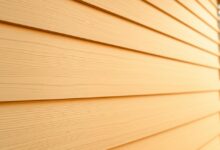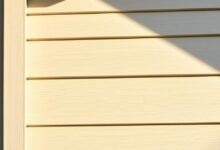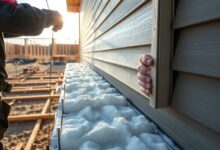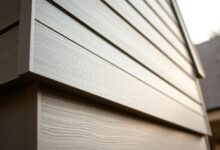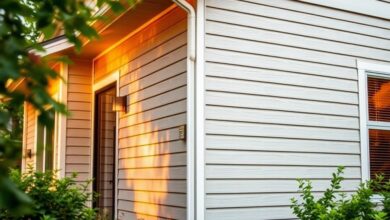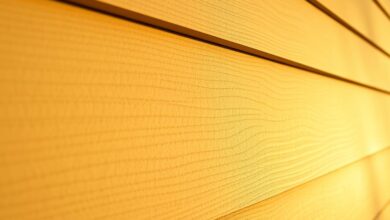Insulated Siding Cost per Sq Ft: A Comprehensive Guide
Adding insulated siding to your home can be a big step. It’s important to know the costs involved. This helps homeowners improve their home’s energy use and look.
The cost per square foot of insulated siding changes based on several things. These include the siding material and how hard it is to install. This guide will cover the different types of insulated siding, their benefits, and how to plan your budget.
Key Takeaways
- Understand the factors that affect insulated siding costs.
- Learn about the different types of insulated siding materials.
- Discover how to budget for your insulated siding project.
- Explore the benefits of upgrading to insulated siding.
- Get tips on making informed decisions for your home improvement project.
What Is Insulated Siding and Why Consider It?
Insulated siding is changing how we do exterior home updates. It combines energy savings with good looks. This new siding adds an extra layer of insulation to your home. It helps cut down on energy costs and makes your home more comfortable.
Definition and Core Benefits
Insulated siding is a siding type with built-in insulation. This key feature cuts down on heat loss between inside and outside. It leads to lower energy bills and a steady indoor climate. The main perks are better energy use, longer-lasting siding, and a nicer look.
Energy Efficiency Advantages
Insulated siding’s main plus is its energy-saving power. It keeps your home warm in winter and cool in summer. This means big savings on energy over time.
Aesthetic and Durability Considerations
Insulated siding also brings a variety of looks to match your home. Plus, it’s built to last, standing up to weather and wear. This makes it a smart choice for homeowners looking for long-term value.
Types of Insulated Siding Materials
The market offers a variety of insulated siding materials. These include vinyl, fiber cement, wood-based products, and engineered wood. Each material has its own set of characteristics, benefits, and drawbacks.
Vinyl Insulated Siding
Vinyl insulated siding is a favorite for its durability and low maintenance. It stands up well against pests and weather. Plus, it’s energy-efficient, helping to keep your home cool in summer and warm in winter.
Fiber Cement Insulated Options
Fiber cement insulated siding is a good choice for those who want durability and style. It’s made from cement, sand, and cellulose fibers. This makes it strong against rot, fire, and pests. It also looks like wood but doesn’t need the upkeep.
Wood-Based Insulated Products
Wood-based insulated siding gives a traditional look. It’s made from natural wood. While it’s pricier and needs more care, it’s a favorite for its unique look.
Engineered Wood with Insulation
Engineered wood siding with insulation offers a natural wood look and better energy use. It’s made by layering wood fibers. This makes it stable and less likely to warp than solid wood. It’s a great choice for those who want both beauty and performance.
Insulated Siding Cost per Square Foot Breakdown
When looking at insulated siding, the cost per square foot is key. This price can change a lot based on the material, its quality, and how hard it is to install.
Vinyl Insulated Siding Costs
Vinyl insulated siding is very popular. It’s durable and saves energy. Prices for it range from $0.80 to $2.50 per square foot. This depends on the quality and brand.
Fiber Cement Insulated Siding Pricing
Fiber cement siding is also durable and insulates well. It costs between $1.00 and $3.50 per square foot. Prices vary due to brand, quality, and product features.
Wood and Engineered Wood Costs
Wood and engineered wood sidings look natural and are durable. Their prices vary a lot, from $2.00 to $6.00 per square foot. This depends on the wood type and craftsmanship.
Premium vs. Standard Options
Choosing between premium and standard siding affects the cost. Premium options have better durability, insulation, and warranties.
| Material | Cost per Sq Ft | Durability |
|---|---|---|
| Vinyl Insulated Siding | $0.80 – $2.50 | High |
| Fiber Cement Siding | $1.00 – $3.50 | Very High |
| Wood/Engineered Wood | $2.00 – $6.00 | High (dependent on type) |
Factors Affecting Insulated Siding Prices
Knowing what affects insulated siding prices is key for homeowners. It’s not just the material that matters. Several factors influence the final cost.
Material Quality and R-Value
The material’s quality and R-value, which shows thermal resistance, greatly impact the price. Better insulation means higher R-values, but it also costs more. It’s important to find a balance between quality and cost.
Brand and Manufacturer Differences
Brands and manufacturers set their own prices based on reputation, production, and material quality. Comparing prices from different manufacturers helps homeowners make a smart choice.
Regional Price Variations
Insulated siding prices vary by region. This is due to demand, local building codes, and transportation costs. Homeowners should consider these variations when planning their budget.
Home Size and Configuration
The size and design of a home also affect insulated siding costs. Larger homes or complex designs need more material and labor. This increases the overall cost.
Installation Costs and Considerations
Insulated siding installation costs can vary a lot. It’s important for homeowners to know what affects these costs. This way, they can plan their budgets better.
DIY vs. Professional Installation
Choosing between DIY siding installation and hiring pros is a big decision. DIY can save money but needs a lot of time and skill. On the other hand, hiring pros ensures quality but costs more upfront.
Labor Costs by Region
Labor costs change a lot depending on where you live. This is because of different living costs, local rules, and contractor demand. Cities usually have higher labor costs than rural areas.
Additional Materials and Prep Work
You’ll need more than just siding. You’ll also need flashing, weatherproofing, and fasteners. Plus, prep work like fixing damaged sheathing or removing old siding adds to the cost.
Removal of Existing Siding
The cost of removing existing siding can be high. This is true if the old siding is damaged or has harmful materials like asbestos. It’s key to include siding removal costs in your budget.
By thinking about these points, homeowners can get a better idea of their project’s total cost. This helps them make smart choices about how to install their siding.
- Be honest about your DIY skills to choose between DIY and hiring pros.
- Look up local labor costs to get a closer estimate.
- Plan for extra materials and prep work.
- Remember to include the cost of removing old siding.
Long-Term Value and Return on Investment
Insulated siding does more than save energy; it also brings a big return on investment. When looking at the cost of insulated siding, remember its long-term gains.
Energy Savings Calculations
Insulated siding cuts down on energy use. It stops heat from moving between inside and outside your home. This can save a lot on heating and cooling bills.
Home Value Increase
Insulated siding also boosts your home’s value. Buyers like homes that save energy. Homes with insulated siding often sell for more.
Maintenance Costs Over Time
The cost of insulated siding at first is key, but so are maintenance costs later. Different materials need different care. Some need more repairs or replacements than others.
Warranty Considerations
The warranty from the maker is also key. A good warranty gives you peace of mind and protects your investment.
How to Budget for Your Insulated Siding Project
To budget for your insulated siding project, consider a few key factors. A good budget helps your project finish on time and within your budget.
Getting and Comparing Quotes
Getting quotes from different contractors is essential. When comparing quotes, look at more than just the price. Check the materials, timeline, and payment terms.
“Getting a fair price means getting multiple quotes and negotiating,” advises a contractor. Comparing quotes carefully can prevent surprise costs later.
Evaluating Contractors
When evaluating contractors, their experience with insulated siding matters a lot. Look for references and check their past work. A good contractor will give a detailed estimate and explain their prices clearly.
- Verify the contractor’s license and insurance.
- Check online reviews and ask for references.
- Ensure they have experience with insulated siding.
Financing Options and Tax Incentives
Looking into financing options can make your project more affordable. Some contractors offer financing, or you might consider a home equity loan. Also, check for tax incentives for energy-efficient upgrades.
The U.S. Department of Energy says homeowners might get tax credits for energy-efficient upgrades, including insulated siding.
Common Cost-Related Mistakes to Avoid
Avoiding common mistakes can save you money and stress. One big mistake is not budgeting for unexpected costs. Always have a buffer in your budget for surprises.
Another mistake is not doing your research on contractors. This can lead to poor work and extra costs. Being well-informed and prepared ensures your project goes smoothly.
Insulated Siding: A Valuable Home Investment
Insulated siding boosts your home’s energy use, looks, and value. This guide has covered the types of siding, cost factors, and installation tips.
Knowing about insulated siding summary and siding cost summary helps you choose wisely. Whether it’s vinyl, fiber cement, or wood, think about quality, brand, and local prices. This way, you can plan your budget well.
Getting the siding installed right is key. Now, you’re ready to improve your home. You’ll enjoy better comfort, value, and looks.
